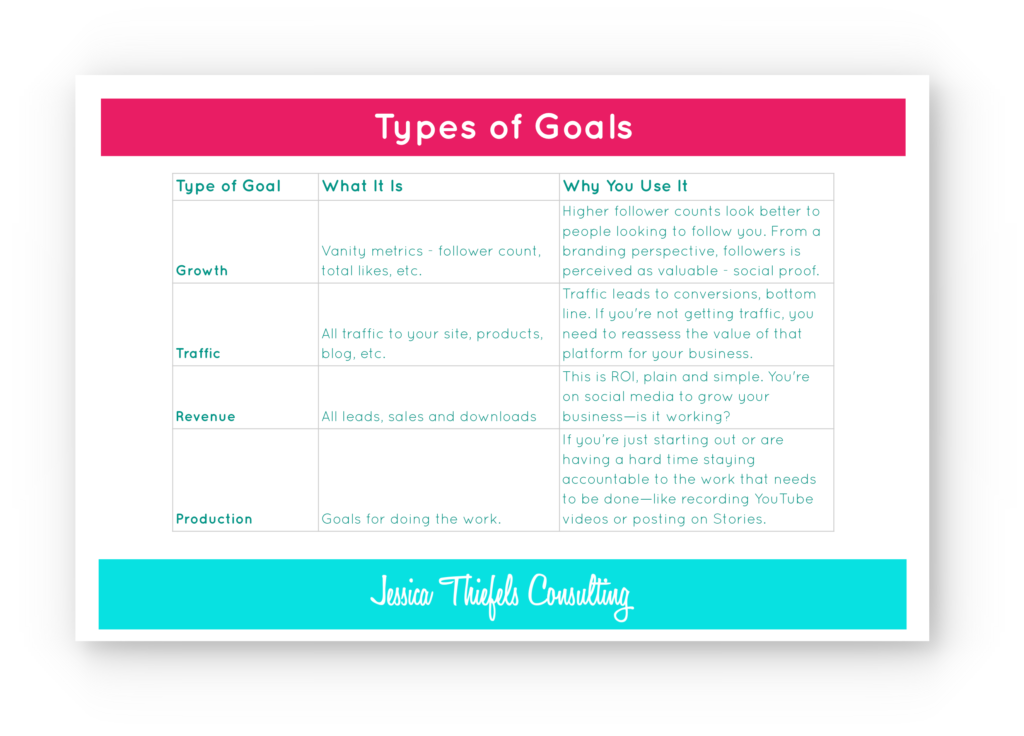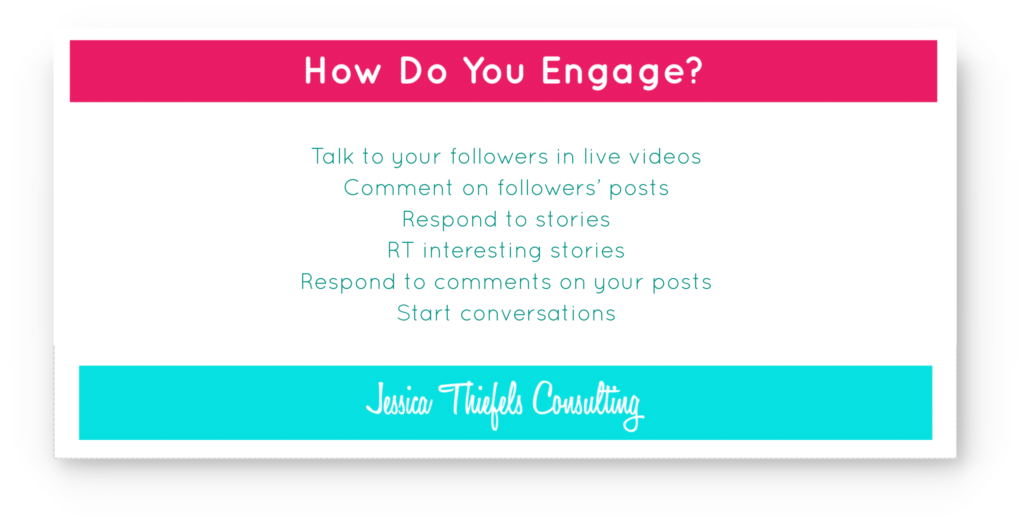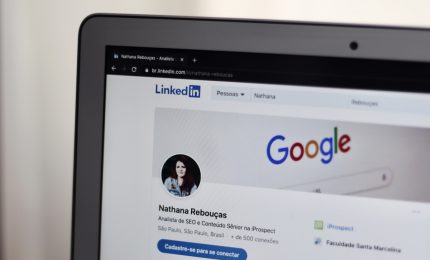This isn’t just a regular list of ideas for your social media strategy. Much of what’s available online has been regurgitated time and time again. In my seven years in marketing, I’ve slowly begun to learn what’s important and what’s not when building a strategy—and it’s often not the traditional methods that are the most effective.
For example, it’s important to set goals that are tied to your business objectives. It’s also important that they’re each tied to a specific platform, rather than having five or six goals as a general, overarching “social media goals.”
That’s why we’re talking a different angle, talking about the five non-traditional pillars of social media strategy, which include:
- Platform-Specific Goals
- Selective Use of Platforms
- Alignment With Brand
- Focus on Engagement
- Data-Centric Decision-Making
Dive in and get ready to create a kick ass social media strategy you can be proud of.
Every Social Media Strategy Needs: Platform-Specific Goals
A great social media strategy is built upon goals that are tied to your business goals—but more specifically, goals that are specific. I’m not talking your standard SMART goals here. When I’m helping clients develop their social media strategy, we focus on goals that are not just specific to the outcome, but to the platform itself. What do I mean?
Bad goal:
- I want to drive sales from social media.
Good goals:
- Get 5 new clients from Instagram.
- Drive 3 clients from Facebook.
- Earn $500 in sales from Pinterest.
When we set goals, they tend to be general. When we hone in on goals for each platform, you can be more intentional and structured in your approach. If you know you want to drive $500 in sales from Instagram, for example, you’ll be sure to find creative ways to share and plug your brand. You’re also more likely to be using features like product tagging to drive those sales.
The question is: how do you know which goals to set for which platform? Start with your own data and ask yourself: What value is each of these platforms already providing? For example, perhaps you’re seeing that Instagram drives the most downloads to your freebie opt-in. In this case, you may set a goal to increase those downloads from 10 each month to 20.
If you don’t have any historical data yet, there are a few ways to start getting goals. In this case, your goals will likely need to be focused on production and growth so you can focus on building an audience and collecting the data.
I like to organize goals into four categories, so when I say “goals focused on production and growth” I mean:

Don’t forget to write your goals down! Use my Goal-Setting Template (the same one I use with ALL of my clients) to get them organized, platform by platform. I encourage my clients to set one goal for every category (Growth, Traffic, Revenue and Production). At the end of the month, go back through to note which goals you hit and which you didn’t by downloading the template in the bottom right corner. Did you already close out of it? Just refresh the page and it will come back up!
Every Social Media Strategy Needs: Selective Use of Platforms
We want to be everywhere, all the time—more than want, we feel like we need to. But it’s better to do really well in one or two places, than do crappy in 4 or 5 places. Consider this: a potential client reaches out to you on Instagram, but you’re not active there, so you miss the message and lose a client. Suddenly, you’ve lost business and made your brand look bad.
To choose which platforms you should be on, start with your data. What is already working for you and what isn’t? If you don’t know that just yet, consider:
Where you audience is: How do you know where you audience is? Check out the simple outline below. While these aren’t strict guidelines, they can be helpful in narrowing down your options to get started with just one or two of the best platforms for your business.

Brand alignment: When you consider which platform is best for your brand, ask yourself these questions:
- Is image, video or text-based sharing better for your brand?
- What are your goals?
- What are your skills? Video versus photography versus writing?
- Are you reaching a professional audience or playful audience?
For example, if video is critical to your brand, and you’re targeting millennials, YouTube and Instagram are likely great platforms for you. If you’re using a professional approach and tone, and selling to executives, LinkedIn may be the platform for you.
Every Social Media Strategy Needs: Alignment With Brand
Aligning your social media strategy with your overall brand is critical. If people do what you want them to do—click through to your site, read a blog post, or follow you on another social media platform—you want the experience to be consistent.
Think about the brands you love the most: Starbucks, Facebook, Uber, REI. No matter where you are, physically or digitally, or what you’re looking at, you’ll recognize their brand right away.
You may be thinking that, as a small business or startup, this isn’t important. Quite the contrary, it’s critical as you grow a following. To develop brand recognition, and build a loyal customer base, you have to be consistent.
This consistency comes through in:
- How the social post relates to the page you’re directing them to. If you’re talking about the new fall running shoes, the page you tell them to visit better be about the new fall running shoes.
- How your voice translates between text and video. If you’re very serious in post captions but silly on your videos, there’s a disconnect.
- How your website looks compared to how your social media looks. Are all the colors, design and feel consistent across the board? This is crucial for brand recognition. It’s hard to stand out in our crowded online space and your brand helps you do that.
In terms of being most effective, you also need to maintain alignment between your business goals and your social media profiles. If your business goal is to sell 50 shoes by year end, then your social media should be supporting that. As you fill out your goal sheet, keep this in mind.
Every Social Media Strategy Needs: Focus on Engagement
Consumers want two things from you on social media right now: authenticity (I’ve talked about this before) and recognition. While most social media strategies are focused on posting and scheduling, few have engagement built into the plan. When you engage, not only are you able to share that authentic voice, but you give consumers the customer experience they want.
What is the experience they want? According to CMO Council (paid report download), the top three attributes of a positive customer experience are:
- Fast response time
- Knowledgeable staff, ready to assist
- Rewards and recognition for loyalty
Not only does social media engagement allow you to do this, but by being present, you begin to nurture drive brand advocates. According to ICMI, advocates spend twice as much as regular customers, and are 70 percent more likely to be seen as a good source of information by the people around them
Even as a small brand or entrepreneur, you can develop brand advocates. In fact, you probably already already have some: think about that one friend that shares all your posts. That friend is a brand advocate for your small business or startup.
Now imagine if you had dozens—or hundreds—of those. Create your own brand advocates by engaging with all different tactics:

Every Social Media Strategy Needs: Data-Centric Decision-Making
If you’ve ever read any of my blog posts or been to any of my trainings, you know that I’m a data head. That’s because, in 7 years of working in marketing, I’ve learned there’s no other way.
The best way to build data-centric decision-making into your social media strategy is to do monthly reporting. Check out some of my recent marketing reports as you begin to build yours. If you’re not sure where to start, simply start tracking the following data points in a Google Sheet:
- Total followers
- Most popular posts for the month (comments and likes)
- Traffic to your site/products/downloads
- Sales/clients earned
- Audience engagement and engagement rate
As you consistently report the numbers, you’ll start to see patterns. Let those guide the changes you make. When you know what’s working and what’s not, you’ll be able to optimize your efforts. If you’re still feeling lost, check out my blog post: Social Media Analytics Made Simple to explore this topic in more detail.
Curious about being a social media coaching client?
“She unlocked social media clarity for me. If social media feels like throwing Jell-O at a wall right now, do yourself a favor and talk to Jessica Thiefels Consulting!” – Justine Nelson, client and founder, Debt Free Millennials



